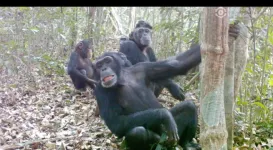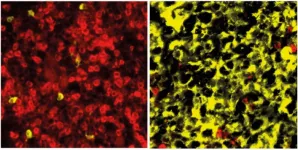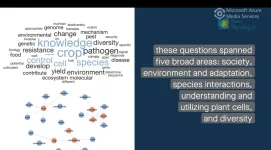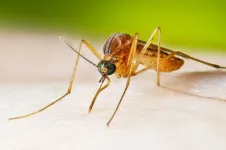(Press-News.org) The western chimpanzees of Guinea are threatened by mining activities. Using a novel genetic approach, UZH researchers and an international team have collected information on population size and community structure of the endangered species. These data provide an important baseline to assess the impact of mining.
The western chimpanzee is listed as “Critically Endangered” on the Red List of the International Union for the Conservation of Nature. The Mount Nimba Strict Nature Reserve, a UNESCO World Heritage site, located on the borders of Guinea, Liberia and Côte d’Ivoire in West Africa, harbors a unique population of this subspecies. However, this region is now under threat from mining activities immediately abutting its borders. Guinea is rich in minerals with some of the highest‐grade iron‐ore deposits in the world. “It is therefore crucial to establish tools to monitor this endangered chimpanzee population and assess the potential impact of mining,” says Kathelijne Koops, professor in the Department of Evolutionary Anthropology at the University of Zurich.
Fecal samples collected over 15 years
To this end, Koops and her colleagues used genetic censusing to estimate chimpanzee population size, community composition and range boundaries on the western flank of the massif in Guinea. The international team included researchers from the University of Zurich, the University of Kent, Copenhagen Zoo, the University of Copenhagen, Texas A&M and the Environmental Research Institute of Bossou in Guinea. “Our study is the first to employ genetics on such a large scale to estimate the number and population structure of a critically endangered chimpanzee population in West Africa,” says Koops. During field work the researchers collected almost a thousand fecal samples of chimpanzees between 2003 and 2018. They analyzed the genetic material contained in these samples using a panel of 26 microsatellites – short pieces of DNA that allow the identification of individual animals as well as relatedness between them.
Genes reveal family ties and migration
The analysis identified a total of 136 chimpanzees living in four different communities or social groups. The actual number of chimpanzees in the area probably significantly exceeds this minimum estimate. “Infants and juveniles are not reliably included in fecal sampling and some areas of the mountain range remain under-sampled”, says Dr. Christina Hvilsom, conservation geneticist at Copenhagen Zoo.
The team also found a number of migratory events, as well as high levels of shared ancestry and genetic diversity. “These findings highlight the utility of genetic censusing for temporal monitoring of ape abundance, as well as capturing migratory events and gauging genetic diversity and population viability over time,” adds co-author Dr. Peter Frandsen, also at Copenhagen Zoo. For example, the data allow predictions to be made as to how road building and extraction activities might affect chimpanzee movement between the different communities or reduce access to food and nesting sites.
New tool for protection of great apes
“This study undeniably confirms the status of the Nimba UNESCO World Heritage Site as a priority site for the conservation of the critically endangered western chimpanzee,” says co-author Dr. Tatyana Humle, senior associate at Re:wild. “It also demonstrates the value of employing non-invasive genetic techniques to generate critical data on population abundance, structure and genetic health.” “For future impact assessments, we recommend genetic sampling, combined with camera trapping, as these methods can provide robust baselines for biomonitoring and conservation management,” says Koops. Not only for the western chimpanzee but also for other species of endangered great apes.
END
Genetics as conservation tool for endangered chimpanzees
2023-03-16
ELSE PRESS RELEASES FROM THIS DATE:
CityU scientists develop energy-saving, tunable meta-devices for high-precision, secure 6G communications
2023-03-16
The future of wireless communications is set to take a giant leap with the advent of sixth-generation (6G) wireless technology. A research team at City University of Hong Kong (CityU) invented a groundbreaking tunable terahertz (THz) meta-device that can control the radiation direction and coverage area of THz beams. By rotating its metasurface, the device can promptly direct the 6G signal only to a designated recipient, minimizing power leakage and enhancing privacy. It is expected to provide a highly adjustable, directional and secure means for future 6G communications systems.
The potential of THz band technology ...
Ochsner Health advances precision medicine, becomes national leader in universal genomic testing for chemotherapy
2023-03-16
New Orleans, Louisiana – Ochsner Health is leading the way for precision medicine nationwide by becoming one of the first hospital systems to standardize genomic testing, significantly advancing ways in which care teams can treat cancer patients. This change helps providers determine individualized treatment by understanding how patients will react to certain drugs, thereby lowering risk of adverse side effects, improving patient experience, and bettering patient outcomes.
Pharmacogenomics, or PGx, testing guides physicians how patients metabolize certain drugs and warns of possible side effects so they may ...
Bigger flowers, greater rewards: Plants adapt to climate disruptions to lure pollinators
2023-03-16
Photos
There's been a well-documented shift toward earlier springtime flowering in many plants as the world warms. The trend alarms biologists because it has the potential to disrupt carefully choreographed interactions between plants and the creatures—butterflies, bees, birds, bats and others—that pollinate them.
But much less attention has been paid to changes in other floral traits, such as flower size, that can also affect plant-pollinator interactions, at a time when many insect pollinators are in global decline.
In ...
Novel disease models for multiple myeloma
2023-03-16
B lymphocytes – also known simply as B cells – play a central role in the immune system. If pathogens enter the body, B cells are activated and develop into plasma cells, which then release antibodies. One important step in this process is the germinal center reaction. If the B cells’ maturation into plasma cells is disrupted, multiple myeloma can develop – one of the most common blood cancers. This disease has a variety of subtypes and is not yet curable.
Multiple myelomas develop very slowly and in several stages. The process is initiated by spontaneous genetic aberrations that occur ...
Scientists identify 100 important questions facing plant science
2023-03-16
What are the key research priorities that will help tackle the global challenges of climate change, the biodiversity crises and feed a growing population in a sustainable way? Ten years after these priorities were first debated and summarised by a panel of scientists and published in New Phytologist, the panel reflects on the changes to plant science and the progress made to address these research areas, published on 16 March in a Letter in New Phytologist.
To re-evaluate research priorities, a new panel was formed in 2022 to provide an international perspective on the important areas for plant science research. This project, ...
Clinical trial investigating innovative way to control Type 2 diabetes
2023-03-16
LOS ANGELES — More than 37 million Americans have diabetes, and approximately 90-95% have Type 2 diabetes.
Diabetes is a chronic condition where the body does not produce or effectively use insulin. A lack of insulin leads to raised blood glucose (sugar) levels, which can cause heart disease and stroke, kidney disease, nerve damage and other severe complications.
Keck Medicine of USC has launched a Phase 2 clinical trial investigating the effectiveness of a new outpatient, nonsurgical endoscopic procedure in stabilizing blood glucose levels for patients.
“Currently, the only treatment for diabetes ...
Humans bite back by deactivating mosquito sperm
2023-03-16
New UC Riverside research makes it likely that proteins responsible for activating mosquito sperm can be shut down, preventing them from swimming to or fertilizing eggs.
The study could help control populations of Culex, the common house mosquito that transmits brain-swelling encephalitis and West Nile Virus.
“During mating, mosquitoes couple tail to tail, and the males transfer sperm into the female reproductive tract. It can be stored there awhile, but it still has to get from point A to point B to complete fertilization,” said Cathy Thaler, UCR cell biologist and the study’s first author.
Key to completing that journey are the specialized proteins secreted ...
New findings published in AJIC highlight clinician perspectives on barriers to reliable hand hygiene
2023-03-16
Arlington, Va., March 16, 2023 – Findings from a new study published in the American Journal of Infection Control (AJIC), highlight perceptions of and barriers to reliable hand hygiene among specific clinician subgroups. The results, from the first study of its kind, provide insights that can be used to design and implement future, targeted interventions to optimize hand hygiene reliability among medical professionals.
“While prior studies focused on challenges to hand hygiene reliability by healthcare role, we believe our study is the first to highlight key differences in perceived barriers ...
Common meat-free proteins may trigger soybean and peanut allergies in some people
2023-03-16
Many people keen to reduce their meat consumption are turning to substitutes made of legumes packed with protein, vitamins, and fiber. But allergies to legumes like soy or peanuts are both common and dangerous. Are patients allergic to particular legumes at risk from meat-free proteins made of legumes even if they contain different legumes? Dr Mark Smits and a team of scientists at University Medical Center Utrecht set out to investigate.
“Both protein consumption and the world’s population are increasing which leads to an urgent demand for sustainable ...
A comprehensive circuit mapping study reveals many unexpected facts about the norepinephrine neurons in the brainstem
2023-03-16
A small nucleus in the brainstem called locus coeruleus (literally the “blue spot,”) is the primary source of a major neuromodulator, norepinephrine (NE), an important mediator of the ‘fight or flight’ response in animals. However, very little is known about the local connections of this small albeit critically important group of neurons. A recent pioneering study published in eLife from the laboratory of Dr. Xiaolong Jiang, investigator at the Jan and Dan Duncan Neurological Research Institute (Duncan NRI) ...







